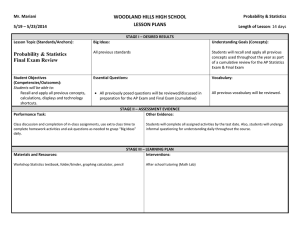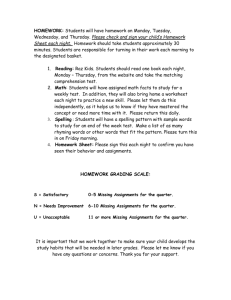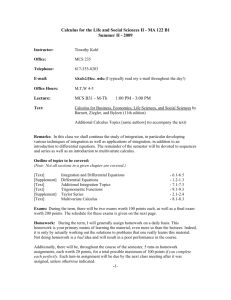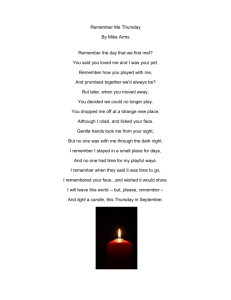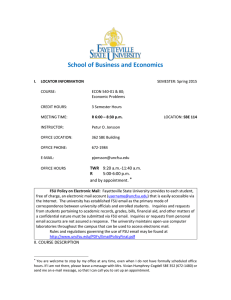PowerPoint - Quark Interactions Experiment
advertisement
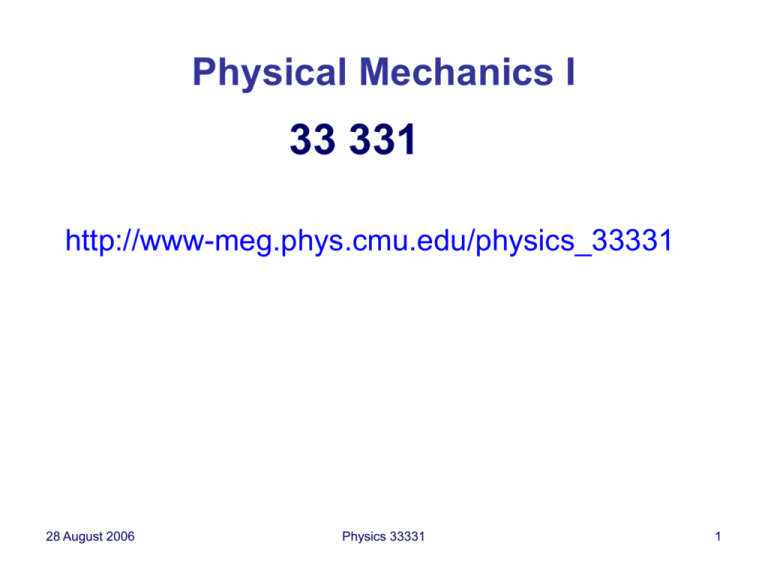
Physical Mechanics I 33 331 http://www-meg.phys.cmu.edu/physics_33331 28 August 2006 Physics 33331 1 Professor Curtis Meyer Ph.D. University of California, Berkeley Wean Hall 8414 cmeyer@cmu.edu (412) 268-2745 Experimental Medium Energy Particle Physics My research is carried out at the Thomas Jefferson National Accelerator Laboratory (Newport News, VA) “Why are quarks forever trapped inside protons and neutrons?” (The GlueX experiment) 28 August 2006 Physics 33331 2 Textbook Classical Dynamics of Particles and Systems Stephen Thornton & Jerry Marion Chapter Chapter Chapter Chapter Chapter Chapter 2: 5: 6: 7: 8: 9: 28 August 2006 Newtonian Mechanics---Single Particle Gravitation Some Methods in the Calculus of Variation Hamilton’s Principle---Lagrangian and Hamiltonian Dynamics Central-Force Motion Dynamics of Systems of Particles Physics 33331 3 Schedule Monday, Wednesday, Friday: Thursday Lecture Recitation We will try to work problems on Thursday, although examples will be intermixed throughout the course. 28 August 2006 Physics 33331 4 Course Grade Exam 1 Exam 2 Exam 3 Assignments Final Exam Total Possible 150 150 150 250 300 1000 Absolute Grading Scale A B C D R 890 to 1000 790 to 889 690 to 789 590 to 689 below 590 28 August 2006 I reserve the right to lower the cut-off points. I will not raise the cut-off points. Physics 33331 5 Exams Exams will be held on Thursday evenings from 6:00pm until 8:00pm. I will try to write approximately 1-hour long exams. If you have a conflict, please let me know about 1 week in advance so that we can schedule alternate time. On the week of the exam, class will be cancelled on both Thursday and Friday. Exam 1 Thursday September 28 Exam 2 Thursday October 26 Exam 3 Thursday December 1 28 August 2006 Physics 33331 6 Assignments Homework assignments will be due about every two weeks during the lecture on Friday. These will be long assignments, so you are responsible for starting them early enough to be able to finish them on time. Please work together on the problems, but the solutions that you hand in need to be your own work. 28 August 2006 Physics 33331 7 Assignments Your assignments should be treated as a report, not simply some scribbled down answers. All final solutions should be recopied neatly onto the sheet that you hand in. Briefly restate the the problem. Define all variables and symbols. Provide relevant sketches. List physics principles involved. Clearly identify approximations. Clearly mark your answers. If relevant, provide discussion on why your answer is correct---dimensions, limits, …. 28 August 2006 Physics 33331 8 Course Goals Learning the concepts, laws and language of classical mechanics, and how to apply them in solving physical problems. To become more comfortable using various mathematical tools such as calculus and differential equations to solve physical problems. To develop other skills which will be useful to you in your physics career such as approximation techniques, symmetry arguments and dimensional analysis. To improve your problem solving techniques by working on such areas as reasoning, logic and intuition. These techniques should be helpful to you in other areas of study. 28 August 2006 Physics 33331 9 Mechanics From earlier courses, we have treated mechanics as forces acting on objects. These forces do work and either cause the objects to move, or change some internal energy of the object. dp Fnet dt 2 WFdr 1 d2r m 2 F dt These lead to equations of motion: x0 28 August 2006 y g z0 Physics 33331 10 Minimization In this course, one of the new things that we will look at are minimization principles---we minimize some quantity along a path. Lagrangian: L = T – U Hamiltonian: H = T + U We will develop a much simpler method of getting at the equations of motion. 28 August 2006 Physics 33331 11 Generalized Coordinates We will be setting up problems in all sorts of coordinate systems---Cartesian, Cylindrical, Spherical, or what ever happens to be convenient. Vector Calculus is a critical language for what we are doing. We need to be familiar with this in all three of the standard coordinate systems. We are not going to cover chapter 1 explicitly. You would be well advised to read through sections 1,2,3,9,10,11, 12,13,14,15,16 and 17. While we will review crucial details as we need them, I am going to assume that all material in these sections is known and can be used. 28 August 2006 Physics 33331 12
